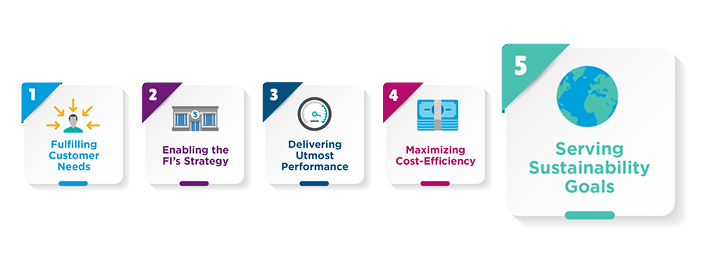By following 5 Golden Rules, financial institutions can unlock the full value of their ATM network and increase their efficiency ratio. Part of a series exploring each rule, this blog focuses on rule #5, operating a more sustainable self-service channel.

By optimizing resources like heating, cooling, lighting, and electronics, FIs can achieve significant savings. And there’s a very innovative and effective opportunity to promote sustainability: leveraging ATMs.
ATMs, with their ability to provide a wide range of banking services, are a sustainable alternative to traditional branches. However, the key lies in implementing the right strategies to maximize their sustainability potential.
Deploying ATMs That Are Built Sustainably
Choosing the right ATM manufacturer is essential. During the selection phase, it is important to ask all the right questions to any new device manufacturer you are considering purchasing from and to verify that sustainability is at the heart of their manufacturing processes. Only opt for a manufacturer who can confirm that not only their operations but also the entire value chain of their suppliers complies with strict diligence processes and code of conduct. Ask about initiatives to reduce waste, prevent pollution, use sustainable materials and conserve resources. Check also how they manage solutions’ end-of-life and whether they take back old devices and ensure they are handled according to high environmental standards. That can mean harvesting them for spare parts, refurbishing systems or recycling the material. More than 90% of the material should be reused in some capacity.
Optimizing the Branch Footprint
Modern ATMs can do so much more than dispense cash—they can act as compact, efficient mini-branches. Deploy devices that combine functionality and compactness, supporting smaller branch formats or even self-service-only pavilions. With the right software, ATMs can even include video-teller capabilities or operate as standalone branches. This approach doesn’t just save space; it also slashes resource consumption.
Cutting Down on Energy Use
Energy efficiency is a critical factor in sustainability. Look for ATMs equipped with energy-efficient LED technology for all illuminated components and intelligent power management to reduce energy usage during standby. Additionally, explore devices that can automatically power down during off-hours and restart when needed. Always review published energy consumption data to ensure you’re making an eco-friendly choice.
Reducing Cash-in-Transit (CIT) Visits
Cash recyclers are a game-changer for sustainability. These ATMs usually feature high-capacity cassettes, reducing the need for frequent cash replenishments by default. Even better, when enabling cash recycling, they refill themselves using deposits from other customers. Investigate the different cassette options and the flexibility to modify configurations to help reduce the need for cash-handling visits. Through more accurate cash usage forecasts and optimized cash services, cash handling visits can be reduced to another greater extent. And fewer armored vehicles on the road mean fewer carbon emissions—a win for the environment.
Maximizing Service Efficiency
Minimizing downtime is not just about customer satisfaction—it’s also about sustainability. Using data-driven service models with preventive maintenance will minimize out-of-service events, leverage auto-recovery and remote resolution whenever possible, and deliver a higher first-time fix rate, leading to a significant reduction of on-site technician visits and vans on the road.
Partnering for Sustainable Success
At Diebold Nixdorf, sustainability is at the core of everything we do. Here’s how we’re leading the charge. We have very strict waste control and reduction initiatives in place and ensure our manufacturing and logistics processes are as environmentally friendly as possible. 97% of the material of our devices is reused in some capacity. DN Series
® and Vynamic
® software can support 95% of typical teller transactions in a footprint of about half a square meter. DN Series enables up to 50% energy consumption reduction compared to the previous device generation. We lead cash recycling technology through market-leading cassette capacity and configuration possibilities, with cash recycling enablement via a simple software update, enabling our customers to reduce cash handling operations by up to 75%. 20% of cash in transit services can also be reduced thanks to more accurate cash usage forecasts and optimized cash services using our Vynamic Cash Management software in-house or leveraging our Cash Forecasting and Optimization managed services. Our data intelligence platform, DN AllConnect
SM Data Engine, which powers our service model enables us to avoid more than 100,000 on-site technician visits and related carbon emissions every year in EMEA only. And up to 35% of incidents are auto-recovered via our Monitoring and Event Management solutions without the need to send any technician. Would you like to know more about how much we can increase the sustainability of your ATM channel and retail banking operations? Let’s work together to reduce carbon emissions for a greener planet and a brighter future.
Start the Conversation


